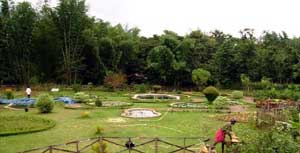
Quick Links
- Arboretum
- Bambusetum
- Cane & Palmetum
- Herbarium
- Orchidarium
- Soil museum
- Xylarium
- Wildlife Museum
- Teak Museum
- Thematic Displays
- Medicinal Plants
- Butterfly Garden
- Insect collection
- Laboratories
- Plant Propagation
- Networks & Helpline
- Monitoring Facilities
- Centralised Facilities
Other Facilities
Other Groups
Nature Trail
 A Bioresource Nature Park was established by KFRI at Nilambur with the financial support from DBT, MoEF and Department of Planning and Economic Affairs, Government of Kerala. The Bioresources Nature Park features conservation themes for groups such as algae, bryophytes, pteridophytes and plants found in specialized ecological niche such as xerophytes (cacti and succulents) and hydrophytes (aquatic plants). Besides these beneficial plants (medicinal plants), ornamental and aesthetic plants (orchids), with special reference to endemic and rare, endangered and threatened (RET) species are also featured in the park. Propagules of over 1200 species of plants have been collected and introduced in the thematic areas of the nature trail. In the orchid house of the park one can familiarize some of the rarely orchids, south Indian endemic species, medicinal orchids and commercially important orchids including some of the prettiest orchids in south India. The Fern House features around 80 species of ferns. The collection includes endemic, rare, endangered and ornamental ferns. The Aquatic plants includes different forms such as floating hydrophytes, submerged and rooted hydrophytes, emergent rooted hydrophytes, and floating leaved and rooted hydrophytes. The Xerophyte and Succulent garden has both outdoor landscaped rock garden and a green house to display medicinal and ornamental species. A collection of bio-fence and bio-fuel species and other attractions. Thallpohyte and Bryophyte specimens are displayed in a specially designed shade house with mist and drip irrigation facilities. In the Palm Garden, besides the 40 ornamental palm species many palms which have economic, ecological and cultural significance are grown. A Taxonomic Garden, where plants of over 100 angiosperm families are assembled is part of the Bioresources Park. The butterfly garden in the Park has been developed by planting larval and adult host plants and subtle modification of the habitat. The juvenile or caterpillar stage of butterflies feed on foliage of specific plants. Thus, it would be possible to see adult butterflies, diverse forms of eggs, caterpillars and pupae of a variety of butterfly species. In a corner of the Bioresources Nature Park, visitors can also see the burials of Megalithic period. These burials, located and reported by one scientist from our Institute, are unique and are about 1800 to 2300 year old. They provide an opportunity to the visitors to learn more about the Megalithic civilization and culture. The archeological and historical importance of Nilambur is evident through this burials.
A Bioresource Nature Park was established by KFRI at Nilambur with the financial support from DBT, MoEF and Department of Planning and Economic Affairs, Government of Kerala. The Bioresources Nature Park features conservation themes for groups such as algae, bryophytes, pteridophytes and plants found in specialized ecological niche such as xerophytes (cacti and succulents) and hydrophytes (aquatic plants). Besides these beneficial plants (medicinal plants), ornamental and aesthetic plants (orchids), with special reference to endemic and rare, endangered and threatened (RET) species are also featured in the park. Propagules of over 1200 species of plants have been collected and introduced in the thematic areas of the nature trail. In the orchid house of the park one can familiarize some of the rarely orchids, south Indian endemic species, medicinal orchids and commercially important orchids including some of the prettiest orchids in south India. The Fern House features around 80 species of ferns. The collection includes endemic, rare, endangered and ornamental ferns. The Aquatic plants includes different forms such as floating hydrophytes, submerged and rooted hydrophytes, emergent rooted hydrophytes, and floating leaved and rooted hydrophytes. The Xerophyte and Succulent garden has both outdoor landscaped rock garden and a green house to display medicinal and ornamental species. A collection of bio-fence and bio-fuel species and other attractions. Thallpohyte and Bryophyte specimens are displayed in a specially designed shade house with mist and drip irrigation facilities. In the Palm Garden, besides the 40 ornamental palm species many palms which have economic, ecological and cultural significance are grown. A Taxonomic Garden, where plants of over 100 angiosperm families are assembled is part of the Bioresources Park. The butterfly garden in the Park has been developed by planting larval and adult host plants and subtle modification of the habitat. The juvenile or caterpillar stage of butterflies feed on foliage of specific plants. Thus, it would be possible to see adult butterflies, diverse forms of eggs, caterpillars and pupae of a variety of butterfly species. In a corner of the Bioresources Nature Park, visitors can also see the burials of Megalithic period. These burials, located and reported by one scientist from our Institute, are unique and are about 1800 to 2300 year old. They provide an opportunity to the visitors to learn more about the Megalithic civilization and culture. The archeological and historical importance of Nilambur is evident through this burials.
Contact: Kerala Forest Research Institute
Peechi P.O, Thrissur District, Kerala - 680653, India.
Tel: +91-487-2690170
e-mail: naturetrail@kfri.res.in
